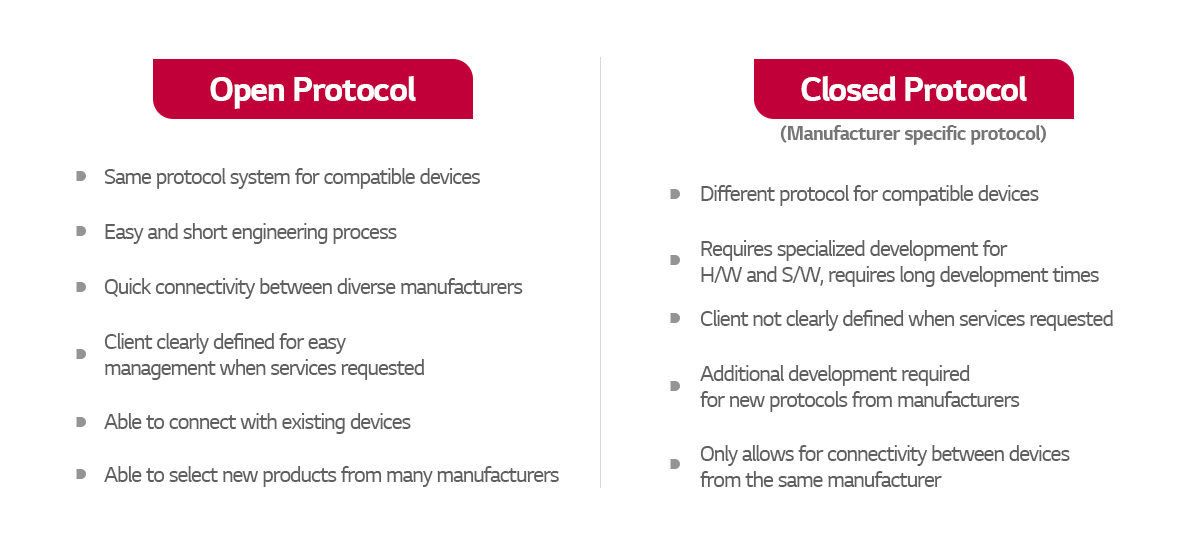If you’ve had the chance to catch the first part in this series, then you also were able to find out what makes up a Smart Home and how an HVAC system can provide a variety of services when combines with Smart Home technology. For part 2, we are all set to learn about the protocols and technologies that make a Smart Home possible.
Open Protocol Connectivity and Standardization Technology Trends
Smart Home and HVAC system connectivity is made possible through a diverse series of Fieldbus protocols. A Multidrop is one of the technologies of Fieldbus protocol, in which all devices are connected to one communication path. A multidrop allows transmission and reception of multiple HVAC system control points within one communication path while providing the advantages of easier installation and reduced costs.
 Major open protocols for HVAC system connectivity
Major open protocols for HVAC system connectivity
Fieldbus also utilizes communication protocols to integrate and control devices in a Smart Home. Many HVAC manufacturers once implemented their own closed protocol systems for communication. However, in the domestic HVAC industry, there is a growing tendency to implement global open protocol systems, such as BACnet, LonWorks, and Modbus.
 Characteristics of open protocols and closed protocols
Characteristics of open protocols and closed protocols
Among these open protocol providers, the easy to develop and manage Modbus, which was developed as a free open protocol by Schneider Electric predecessor Modicon, is often being used for interconnectivity with residential HVAC systems, Smart Homes and wall-mounted control pads. When a wireless wall pad is connected, it accesses the internal cloud server and makes it possible to remotely control the HVAC system from IT devices such as smartphones, tablets and PCs.
 Companies that provide connectivity with the HVAC Modbus protocol
Companies that provide connectivity with the HVAC Modbus protocol
2) IoTivity and the OFC (Open Connectivity Foundation)
The OCF (Open Connectivity Foundation) used to utilize unique manufacturer platforms and closed protocols for household appliances and devices, including HVAC systems, making connectivity a challenge. So, the OCF standardized IoTivity* based on open source platform technology to connect billions of devices in an IoT environment regardless of the operating system or protocol.
 Source : https://openconnectivity.org
Source : https://openconnectivity.org
OCF Structure
In this way, it is possible for devices to communicate without physical Smart Home connectivity or user interaction and allow improved efficiency and the user experience over using each company’s operating system.
 Source : https://openconnectivity.org
Source : https://openconnectivity.org
OCF Architecture
In 2014, OCF began forming the OIC (Open Interconnect Consortium) along with Intel and Samsung Electronics. With the integration of UPnP (Universal Plug and Play) in 2016, OCF provides the standardized technology with over 300 global companies including Samsung Electronics, LG Electronics, Haier, Qualcomm, Microsoft and Cisco.
 Source : https://openconnectivity.org
Source : https://openconnectivity.org
OCF Diamond Members
There are 5 levels of OCF members divided into Diamond, Platinum, Gold, Non-Profit Gold and basic. Diamond is the highest level and Diamond level member companies are able to vote for OCF executives such as board chairs, senior officials and representatives.
 OCF Service Structure
OCF Service Structure
OCF operates as a client-server model. Each server has its own diverse set of IoT service resources that it is able to provide. For example, the HVAC OCF server has a defined set of HVAC service (ON/OFF/MODE/SET TEMP/FAN SPEED and etc.) resources and the OCF client (ex. user smartphone) can use the required services. Therefore, it is possible to utilize the desired control services through a series of processes similar to the following: resource registration device/resource detection resource condition query resource condition resolution resource condition monitoring.
 Protocol standard for Smart Home Devices
Protocol standard for Smart Home Devices
Approximately 75 billion devices will be connected to bring on the era of IoE (Internet of Everything), which implements IoTivity beyond just connectivity. IoTivity is a standard for open source software for IoT. Each object will be connected with IoTivity to exhibit more intelligent and efficient performance than ever before. With the HVAC industry moving past the obstacles presented by closed protocols systems, I genuinely anticipate HVAC to implement more progressive standard technology and become a leader in the business ecosystem of the future.



































